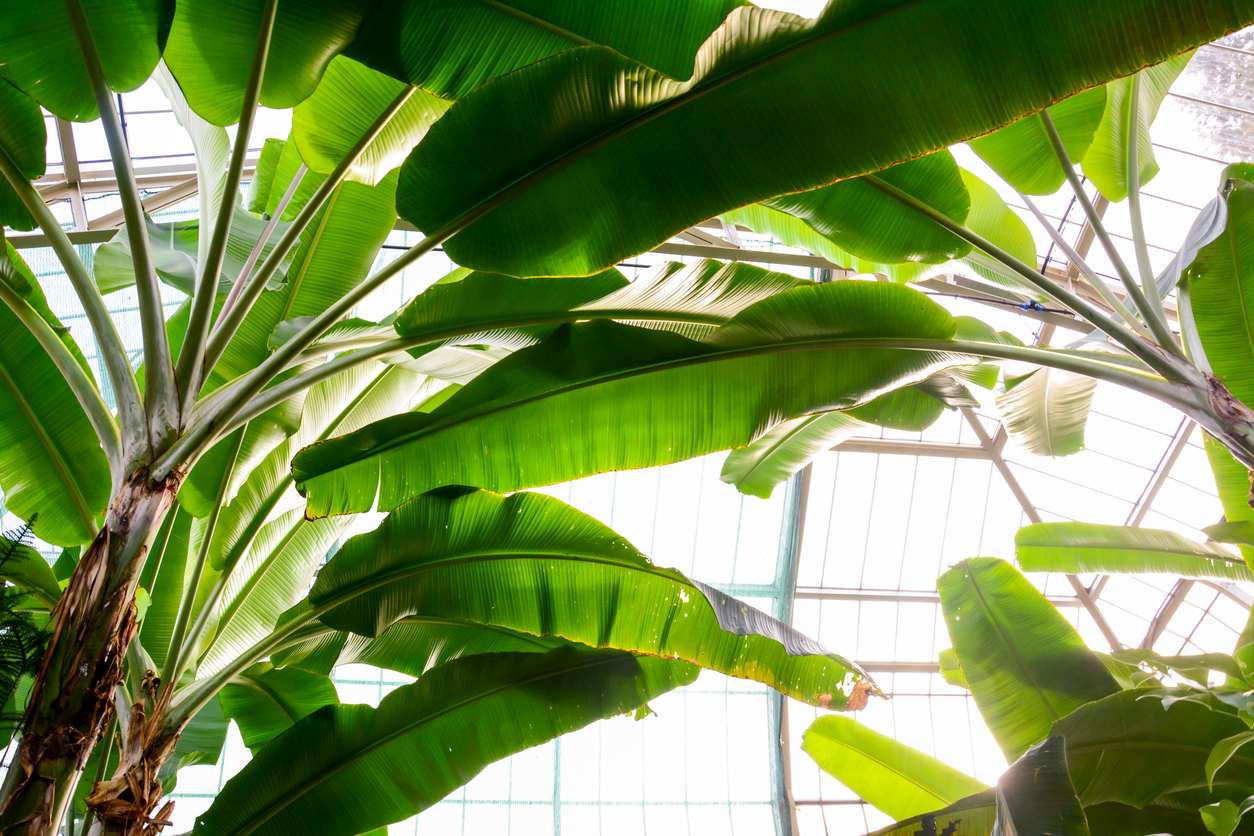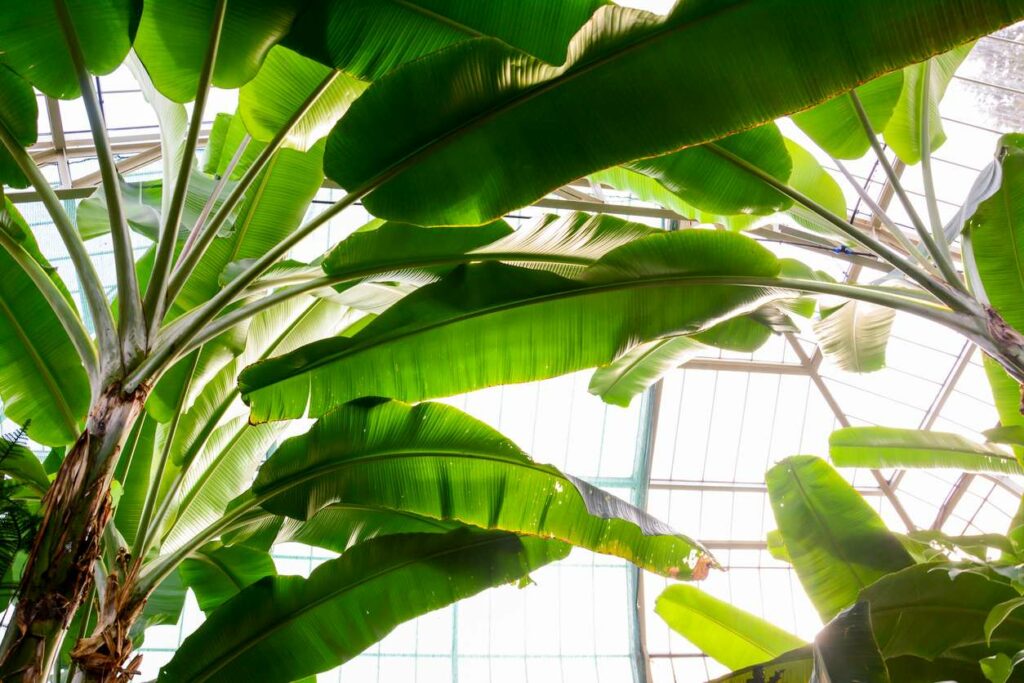Banana Plants – Grow, Care For, And Harvest A Banana Tree In Your Garden
Of all the fruit trees you can grow in your garden, banana plants are probably the most demanding. It’s not just that the soil, weather conditions, and light have to be right. They also have their own way of propagation and need special care when it comes to pollination.
But once you get over all these hurdles, banana plants reward you with yummy and nutritious fruits. Bananas are rich in potassium, manganese, fiber, and copper. They’re also packed with vitamins B6 and C which boost your immune system and fortify you against the common cold.
Even banana peel can go into compost and they whiten your teeth. As for the fruits themselves, they are good to eat raw or they can be used in recipes that range from pies, fruit smoothies, cookies, cakes, and even bread. So what’s there not to like about the humble banana? If you are thinking about growing banana trees in a corner in your garden, this post guides you through this process.
Banana Plants at a Glance
While often called banana trees, bananas are actually herbs. And they’re perennial herbs at that. So what about that trunk? Well, actually that’s not a trunk. That’s just leaves wrapped tightly around each other to help the plant stand upright and reach the sun. In fact, there’s nothing woody about this plant.
The way this plant grows is just as fascinating as every other aspect about it. Young leaves usually grow out of the center of the perennial herb pushing the older leaves out. That’s how the plant keeps pushing upwards until it reaches its full height. That height varies as well depending on which cultivar you grow. One cultivar called “Truly Tiny” won’t grow an inch about one and a half foot no matter how hard you tried. At the same time, a giant like the “Cuban Red” grows to 25 feet high.
Native to Southeast Asia, banana plants have hardiness zones between 9 and 11. Purple stalks grow out of the center of the plant just like another leaf but these open up into white flowers. Once the flowers have been pollinated they fade and make way for the fruits to grow. This process can take up to 9 months until the fruits are fully developed and ready to harvest.
Banana Plants Varieties
As you’re probably aware by now, in most cases, cultivars make great candidates for your garden than the natural species. This applies to banana plants more than any other fruit tree. That’s because banana cultivars are more tolerant of adverse weather conditions that natural species just couldn’t survive. Luckily there are over 1,000 banana cultivars to choose from. Here are some of the most popular ones.
- Cavendish: A popular cultivar that gardeners grow for its abundance of crops. The fruits are sweet and fleshy making them ideal for desserts and fruit salads. It’s a tall and robust plant although some cultivars are tiny and average 4 feet.
- Cuban Red: A giant of a plant and reaches 25 feet with ease. The fruits are not as flavor-packed and sweet as other types. Mostly you’d use these bananas in cooking and baking.
- Blue Java: A fancy name for a fancy cultivar. It goes well in deserts and ice creams thanks to its soft texture and extra smoothness. It got this name from the bluish hues of the skin of the fruit. Each banana fruit can reach 9 inches while the plant itself grows to 20 feet. It can take up to 2 years from the time you plant it before you actually see any fruits on it.
- Manzano: While not as large as Blue Java, the fruits of Manzano are still sweet enough for them to earn a place on your dessert recipes. The fruits are about 6 inches on average which are not that small banana-wise. You’ll need to wait for about 15 months to get the first crop out of these plants which grow to 15 feet.
- Gros Michel: If you’re lucky to live in the southern parts of the country where it’s hot and humid most of the year, then you can grow Gros Michel. It needs high temperatures but it also rewards you with unimaginable flavors.
How to Grow Banana Plants
The first thing you’ll know when you try to grow banana plants is that you can’t use seeds. Banana seeds are just infertile and will not germinate. That leaves division as the only way to propagate these perennial herbs. Luckily, that’s not as complicated or messy as it may sound. Although, a forewarning, it’s not very straightforward either. Let’s see how you can grow banana plants in easy steps.
- From a fully grown banana plant look for the growth around the base of the stem. The plant will grow 3 or 4 of these to stabilize it.
- Use a sterilized blade to cut one of those suckers at the stem. Choose one that has a leafy growth and is at least 3 feet tall.
- Make sure the sucker has roots since that will speed up the planting.
- Prepare your soil in advance and break the topsoil with a hoe or spade. Mix in a generous portion of organic compost and other materials since bananas thrive in rich soil.
- Leave the tilled soil to rest in the sun for a couple of weeks before you plant.
- Dig a hole in the soil as deep as the length of the root ball of the sucker.
- Plant the suck in the hole and make sure the roots are stretched out to fill the hole.
- Fill the hole with soil and compost and pack it to keep the sucker standing upright and push air pockets out of the hole.
- Water the soil thoroughly to help the soil settle and nourish the roots.
- Keep the soil moist but not wet. Don’t let it dry out. Banana plants crave lots of water.
Banana Plants Care
It’s not easy to get it right the first time. Especially if you have little gardening experience or you have never grown banana plants before. But once you got your first banana up, you’ll get the hang of it. Now, let’s see how you can care for banana plants and ensure you get your first batch of yummy bananas.
Watering
You probably noticed that banana plants are not trees with woody trunks. It’s all leaves full of juices and the plant supports itself with pups which are also full of sap. What this means to you as a gardener is that you need to keep your plant irrigated at all times. But since the roots of the plant are shallow and don’t penetrate the soil, that means two things. The first is that you need to keep the soil moist at all times to keep your banana plant happy and growing. The second is that those shallow roots are sensitive to soaked or waterlogged soil and would rot easily. The golden rule of thumb here is to keep the soil moist and not let the plant starve for water.
Fertilizer
In addition to the organic materials and compost you enrich the soil with when planting banana plants, you also need to fertilize it. You can use any general-purpose fertilizer as long as you apply it correctly. Again you have to keep in mind those sensitive roots that are so close to the surface. As a heavy feeder, the banana plant loves plenty of nutrition. So spread the fertilizer in a circle around the base of the plant without letting it touch it directly. You’ll need to feed the plants about once a month. Consider increasing the dose of potassium in the fertilizer since bananas are rich in it.
Pruning
Bananas like many other aspects of their life rely on the laws of hit or miss to get their fruiting right. When the banana plant is ready to produce fruits, which would usually take long months, it starts to grow several stems out of its center. In theory, any one of those stems should be able to turn purple, pop out a flower then pollinate. But that doesn’t always happen. So that leaves several wasted stems drawing up a lot of precious resources. You need to trim away those useless stems. The same applies to the stalk that produced the fruit. After harvesting, cut it back and let it die. And while you’re at it, remove all the dead growth and fallen leaves to encourage the plant to grow new ones.
Pests and Diseases
While not exactly a disease, you should not let your banana cultivar grow in weather where the temperature drops below 57 degrees F. Cold weather and frost will kill the plant outright. Some cultivars can grow in hardiness zone 5. But the rest will stop growing when it gets cold.
Snails are some of the peskiest pests that attack your banana plant and eat the leaves. Since the plant is mostly just leaves, those pests can damage your plant. Pick them up by hand and get rid of them in a safe and humane way.
Panama wilt is a common disease with banana plants where the lower leaves turn yellow and fall off. If left untreated, you could lose all your banana plants. So use a fungicide to treat this fungal disease.
Harvesting and Storing
From the time the white flower pollinates and fades you can wait in anticipation for the hand of bananas to grow and develop. Most cultivars would take anything between 15 and 18 months to produce their first crop. Usually, that hand of bananas develop in late summer and take the whole winter to grow slowly and mature. By mid-spring, they’re ready for harvesting. You’ll need to cut the whole stalk when the bananas are still green. Don’t let the banana ripen on the plant since that attracts rodents.
Keep the stalks of bananas in a dry and warm place to ripen. To store ripe bananas, peel them off and keep them frozen.

